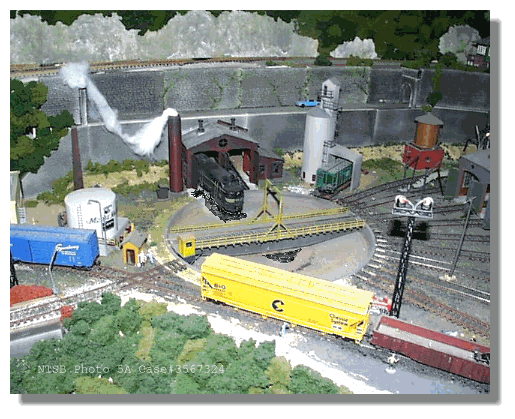
The Moose Valley wishes to express its appreciation to the NTSB for furnishing this report.

Railroad Accident Brief [PDF version]
LAX 99 FR 3567524
DERAILMENT AND HAZARDOUS MATERIALS RELEASE
MOOSE VALLEY RAILROAD
BERKELEY SPRINGS, WEST VIRGINIA
NOVEMBER 6, 1974
Accident Description
On November 6, 1974 at about 5:55 p.m., eastern standard time, Western Maryland Railway locomotive FA-2 #304 derailed while exiting roundhouse stall 8 in the populated section of Morgan County. The engine's three-member traincrew consisted of a locomotive engineer, a student locomotive engineer, and a roundhouse foreman. According to the roundhouse foreman, the unit was being operated by the student engineer. As the prime mover was started the unit drifted out of the stall. It began gaining speed and eventually ran away. The runaway unit partially left the stall track, ending up in a suspended position over the turntable pit. The turntable was aligned for the number 1 stall, and was not in any way damaged.
The derailment resulted in injury to both engineers. The roundhouse foreman, who was on the ground during the runaway, survived with no serious injuries. As a result of the derailment 2,606 gallons of diesel fuel and 15 gallons of sulfuric battery acid, both regulated hazardous materials, were released. Four family members living on a nearby farm upwind were evacuated from the area. Monetary damage was estimated to be $.8 million. Containment of most of the diesel fuel was facilitated by the turntable pit itself, which was later pumped out and put back into operation. The battery acid seeped into the ground, and ground monitoring is on going.
The locomotive engineer has primary responsibility for train control. Other train crewmembers share some responsibility, but generally only after some action or inaction on the engineer's part. An engineer can and should provide the opportunity to run the train to a student engineer, but the engineer remains responsible for ensuring the train is handled in a safe and acceptable manner.
Probable Cause
The National Transportation Safety Board determines that the probable cause of this accident was the mismanagement of the hand brake by the roundhouse foreman and air brake system by the student engineer, allowing the speed of the locomotive to increase to the point where the brake system no longer had the ability to stop the engine, and the failure of the locomotive engineer to ensure proper locomotive control.
Adopted: November 21, 1974
